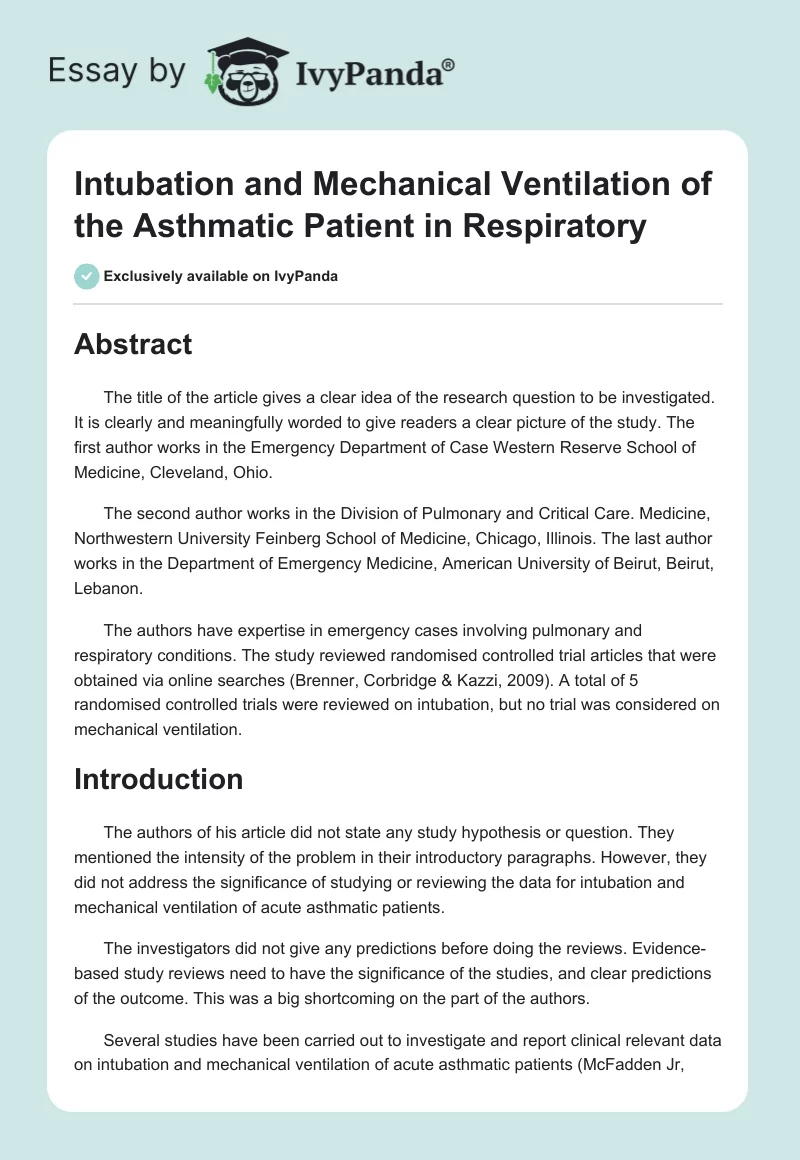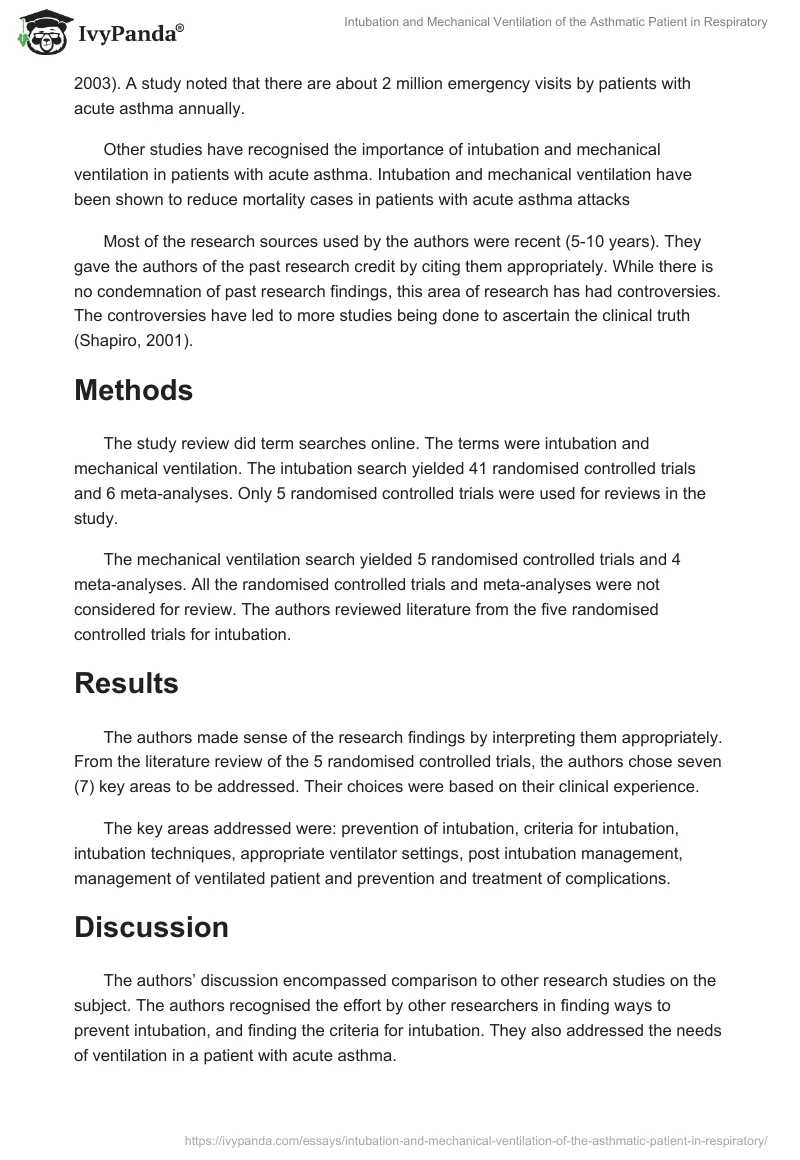Abstract
The title of the article gives a clear idea of the research question to be investigated. It is clearly and meaningfully worded to give readers a clear picture of the study. The first author works in the Emergency Department of Case Western Reserve School of Medicine, Cleveland, Ohio.
The second author works in the Division of Pulmonary and Critical Care. Medicine, Northwestern University Feinberg School of Medicine, Chicago, Illinois. The last author works in the Department of Emergency Medicine, American University of Beirut, Beirut, Lebanon.
The authors have expertise in emergency cases involving pulmonary and respiratory conditions. The study reviewed randomised controlled trial articles that were obtained via online searches (Brenner, Corbridge & Kazzi, 2009). A total of 5 randomised controlled trials were reviewed on intubation, but no trial was considered on mechanical ventilation.
Introduction
The authors of his article did not state any study hypothesis or question. They mentioned the intensity of the problem in their introductory paragraphs. However, they did not address the significance of studying or reviewing the data for intubation and mechanical ventilation of acute asthmatic patients.
The investigators did not give any predictions before doing the reviews. Evidence-based study reviews need to have the significance of the studies, and clear predictions of the outcome. This was a big shortcoming on the part of the authors.
Several studies have been carried out to investigate and report clinical relevant data on intubation and mechanical ventilation of acute asthmatic patients (McFadden Jr, 2003). A study noted that there are about 2 million emergency visits by patients with acute asthma annually.
Other studies have recognised the importance of intubation and mechanical ventilation in patients with acute asthma. Intubation and mechanical ventilation have been shown to reduce mortality cases in patients with acute asthma attacks
Most of the research sources used by the authors were recent (5-10 years). They gave the authors of the past research credit by citing them appropriately. While there is no condemnation of past research findings, this area of research has had controversies. The controversies have led to more studies being done to ascertain the clinical truth (Shapiro, 2001).
Methods
The study review did term searches online. The terms were intubation and mechanical ventilation. The intubation search yielded 41 randomised controlled trials and 6 meta-analyses. Only 5 randomised controlled trials were used for reviews in the study.
The mechanical ventilation search yielded 5 randomised controlled trials and 4 meta-analyses. All the randomised controlled trials and meta-analyses were not considered for review. The authors reviewed literature from the five randomised controlled trials for intubation.
Results
The authors made sense of the research findings by interpreting them appropriately. From the literature review of the 5 randomised controlled trials, the authors chose seven (7) key areas to be addressed. Their choices were based on their clinical experience.
The key areas addressed were: prevention of intubation, criteria for intubation, intubation techniques, appropriate ventilator settings, post intubation management, management of ventilated patient and prevention and treatment of complications.
Discussion
The authors’ discussion encompassed comparison to other research studies on the subject. The authors recognised the effort by other researchers in finding ways to prevent intubation, and finding the criteria for intubation. They also addressed the needs of ventilation in a patient with acute asthma.
The authors discussed the issues on post intubation management, an issue that has been studied by past researches extensively. Their last area to discuss was prevention and treatment of complications arising from mechanical ventilation and intubation.
Research has demonstrated that complications arise in patients who have undergone intubation and mechanical ventilation. Research recommends appropriate procedures for dealing with such complications. Appropriate management of complications helps to save lives of patients (Lougheed, Fisher & O’Donnell, 2006). The authors have failed to mention the limitations and biases, thus they have failed in giving their verdict on the degree of clinical relevance of the studies.
The authors only used 5 randomised controlled trials from intubation searches. They rejected the other trials that were found and all the meta-analyses articles. In addition, the authors did not review randomised controlled trial and meta-analyses articles found on mechanical ventilation.
They did not give the criterion for selecting the articles. The number of articles used for the review was too few to give good conclusion on the subject. In addition, the absence of reviews of articles on mechanical ventilation made the review weak.
Conclusion
The article is quite relevant to respiratory professional care. The article discusses seven key points that are of significance to respiratory professional care. The authors have detailed the processes of intubation and mechanical ventilation in patients with acute asthma.
The authors have also detailed the appropriate actions to be taken when complications arise from intubation and mechanical ventilation procedures. The article gives crucial information relevant to professionals in respiratory care.
References
Brenner, B., Corbridge, T., & Kazzi, A. (2009). Intubation and mechanical ventilation of the asthmatic patient in respiratory failure. Proceedings of the American Thoracic Society, 6(4), 371-379.
Lougheed, M. D., Fisher, T., & O’Donnell, D. E. (2006). Dynamic Hyperinflation During Bronchoconstriction in Asthma Implications for Symptom Perception. Chest Journal, 130(4), 1072-1081.
McFadden Jr, E. R. (2003). Acute severe asthma. American journal of respiratory and critical care medicine, 168(7), 740-759.
Shapiro, J. M. (2001). Intensive care management of status asthmaticus. Chest Journal, 120(5), 1439-1441.


